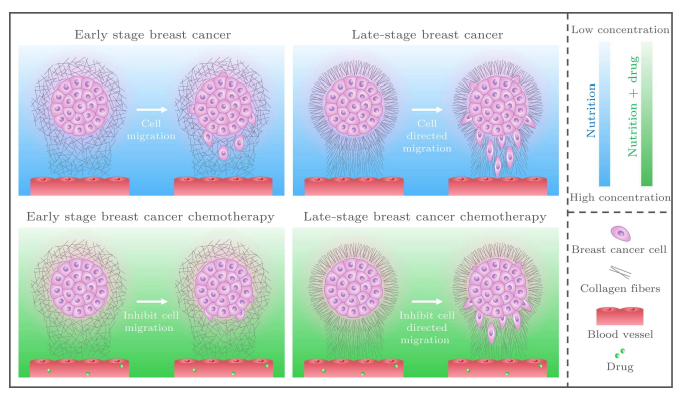|
|
Estimation of cancer cell migration in biomimetic random/oriented collagen fiber microenvironments
Jingru Yao(姚静如), Guoqiang Li(李国强), Xiyao Yao(姚喜耀), Lianjie Zhou(周连杰), Zhikai Ye(叶志凯), Yanping Liu(刘艳平), Dongtian Zheng(郑栋天), Ting Tang(唐婷), Kena Song(宋克纳), Guo Chen(陈果), and Liyu Liu(刘雳宇)
Chin. Phys. B,
2024, 33 (5):
058706.
DOI: 10.1088/1674-1056/ad334c
Increasing data indicate that cancer cell migration is regulated by extracellular matrixes and their surrounding biochemical microenvironment, playing a crucial role in pathological processes such as tumor invasion and metastasis. However, conventional two-dimensional cell culture and animal models have limitations in studying the influence of tumor microenvironment on cancer cell migration. Fortunately, the further development of microfluidic technology has provided solutions for the study of such questions. We utilize microfluidic chip to build a random collagen fiber microenvironment (RFM) model and an oriented collagen fiber microenvironment (OFM) model that resemble early stage and late stage breast cancer microenvironments, respectively. By combining cell culture, biochemical concentration gradient construction, and microscopic imaging techniques, we investigate the impact of different collagen fiber biochemical microenvironments on the migration of breast cancer MDA-MB-231-RFP cells. The results show that MDA-MB-231-RFP cells migrate further in the OFM model compared to the RFM model, with significant differences observed. Furthermore, we establish concentration gradients of the anticancer drug paclitaxel in both the RFM and OFM models and find that paclitaxel significantly inhibits the migration of MDA-MB-231-RFP cells in the RFM model, with stronger inhibition on the high concentration side compared to the low concentration side. However, the inhibitory effect of paclitaxel on the migration of MDA-MB-231-RFP cells in the OFM model is weak. These findings suggest that the oriented collagen fiber microenvironment resembling the late-stage tumor microenvironment is more favorable for cancer cell migration and that the effectiveness of anticancer drugs is diminished. The RFM and OFM models constructed in this study not only provide a platform for studying the mechanism of cancer development, but also serve as a tool for the initial measurement of drug screening.

|
|